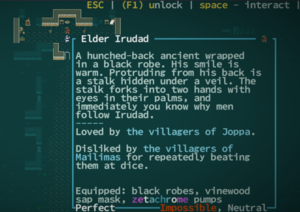Zone tier
| This article has information that is missing or not up to par.
Reason: How is zone tier handled for unique locations, such as the Tomb of the Eaters? |
Reason: How is zone tier handled for unique locations, such as the Tomb of the Eaters?
Each zone (or screen) that a player explores has a particular difficulty tier associated with, often referred to as the Zone tier.
Zone tier is determined based on a combination of the following elements:
Calculating a Zone's Tier
To determine a zone's tier:[1]
- Find the world map tier of the current parasang. These numeric tier values are pictured in the Base Difficulty Tier of World Map Parasangs section below.
- Modify that value based on the current depth:
- The zone tier is unchanged for the surface level and levels 1-4 underground.
- Otherwise, the zone tier is increased by Floor(Depth / 5). Depth 5-9 increases the zone tier by 1, depth 10-14 increases the zone tier by 2, and so on.
- As an example, if the player digs beneath a
 jungle biome (world map tier 3), the zone tier at depth 17 will be 6.
jungle biome (world map tier 3), the zone tier at depth 17 will be 6.
- As an example, if the player digs beneath a
- Finally, modify the result to ensure it is a number between 1 and 8. If a calculation would result in a zone tier value lower than 1 or higher than 8, the result is always constrained to the nearest number within the 1 to 8 range.
Tiers and Procedural Generation
A location's zone tier is generally used as a rough guide for procedural generation of creatures and items in that zone.
For example, in an area with a zone tier of 5, tier 5 creatures (such as ![]() dynamic turret tinkers) and tier 5 items (such as
dynamic turret tinkers) and tier 5 items (such as ![]() fullerite gauntlets) are more likely to be found. Note that zone tier is only one of several factors that affects the dynamic generation of creatures and objects in the world. Specific biomes, unique locations (such as historic sites or dungeons), or other factors can influence the objects and items that are generated in particular zones. This is why, for example, the surface levels of the
fullerite gauntlets) are more likely to be found. Note that zone tier is only one of several factors that affects the dynamic generation of creatures and objects in the world. Specific biomes, unique locations (such as historic sites or dungeons), or other factors can influence the objects and items that are generated in particular zones. This is why, for example, the surface levels of the ![]() desert canyons will always contain the same primary creatures, such as
desert canyons will always contain the same primary creatures, such as ![]() snapjaws,
snapjaws, ![]() equimaxes, and
equimaxes, and ![]() giant dragonflies - this biome has its own unique population/encounter tables.
giant dragonflies - this biome has its own unique population/encounter tables.
Most biomes have unique generation tables defined for their surface and levels 1-5 underground.[2] Once you descend to level 6 or lower in most areas, creature and item generation typically starts to be more directly correlated to zone tier, creature tier, and item tier, and is less strictly defined by biome-specific spawning logic.
There is also an element of randomness at play. For example, the dynamic loot tables for each zone tier have a small chance to roll upward one tier higher. This effect can chain in succession (although at very low probability), sometimes resulting in loot several tiers higher than expected. For example, ![]() Elder Irudad may spawn with tier 8
Elder Irudad may spawn with tier 8 ![]() zetachrome pumps in
zetachrome pumps in ![]() Joppa at the start of the game, even though Joppa has a very low zone tier.
Joppa at the start of the game, even though Joppa has a very low zone tier.
Creature Tier
Creature tier is based on level. Creatures of levels 1-9 are tier 1 for the purposes of dynamic zone generation. A creature's tier increases by one for additional each five levels (creatures of levels 10-14 are tier 2, creatures of level 15-19 are tier 3, etcetera).
Note that this logic for creature tier varies slightly from how a creature's XP tier is calculated (XP tier can go as low as 0). For more information about XP tiers, refer to the Experience page.
Item Tier
Item tier is manually specified for each item in the game's ObjectBlueprints.xml. You can view the tier of a particular item on its wiki page.
Base Difficulty Tier of World Map Parasangs
Each parasang of the world map has a base difficulty tier associated with, as shown on the following numeric overlay:
These tiers can be found looking in Test.txt, titled "JoppaWorld_ZoneTier".
33333333322324444444444444444444444444444444444444444444444444444444444444444444 33333333223324442222222444232333333344333333333333333333333355555555555555555555 33333333322224222222222222333333333334433333333333333333333355555555555555555555 33333333322222222222222225333333333333433333333333333333333355555555555555555555 33333333332222222222222233333333333344433333333333333333333355555555555555555555 23333333333111112222223333333333333343333333333333333333333355555555555555555555 33333333333311222211223333333333333343333333333333333333333355555555555555555555 33333333333311222111232333333333333343333333333333333333333355555555555555555555 33333222222112221112233333333333333343333333333333333333333355555555555555555555 33332222222122212112233443344444333443333333333333333333333355555555555555555555 33322222222111222122233333433333333433333333333333333333333355555555555555555555 33222222222112221222333334444433334433333333333333333333333355555555555555555555 32222222222221222212233333333344444333333333333333333333333355555555555555555555 22222222222222122112244443433444444333333333333333333333333355555555555555555555 22222222222222122212223343334444444333333333333333333333333355555555555555555555 22222222222211112222233333344444443333333333333333333333333355555555555555555555 22222222220111111112223333444444333333333333333333333333333355555555555555555555 22222222200211111211223444444433333333333333333333333333333355555555555555555555 22222222201111111211344433433333333333333333333333333333333355555555555555555555 22222222000111112211333344433333333333333333333333333333333355555555555555555555 22222222200111112113333343333333333333333333333333333333333355555555555555555555 22222220000000112211134443333333333333333333333333333333333355555555555555555555 22222220000000111222133333333333333333333333333333333333333355555555555555555555 22222000000001111122213313331113333333113333333333333333333355555555555555555555 22222000000011121222221111111111111111223333333333333333333355555555555555555555
References
| This information is reliable as of patch 2.0.201.49. |
